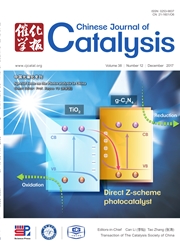

 中文摘要:
中文摘要:
从煤、生物质或天然气出发经甲醇制烯烃正在成为最重要的非石油路线低碳烯烃和液态燃料的生产途径.基于SAPO-34和HZSM-5催化剂,甲醇制低碳烯烃(MTO),甲醇制丙烯(MTP)和甲醇制汽油(MTG)已经实现了工业化.与此同时,甲醇制烯烃反应机理也一直是学术界和工业界研究的焦点,然而由于甲醇转化机理十分复杂,且往往受多种因素的影响,使得机理研究工作至今未给出明确详尽的结论.据文献报道,在具有较大笼或交叉孔道结构的SAPO-34,SSZ-13和Hβ催化剂上,甲醇转化主要是通过烃池机理进行.烃池物种包括多甲苯及其对应的质子化产物.随着HZSM-5上甲醇转化双循环机理的提出,近期人们开始关注一维孔道分子筛上的甲醇转化反应,试图通过抑制芳烃循环使得甲醇转化主要通过烯烃甲基化裂解机理进行,发现在具有一维十元环孔道结构的HZSM-22分子筛上甲醇转化能够达到这一效果,产物主要以C3^+烯烃为主,乙烯的生成较少.该催化体系的发现对于甲醇制丙烯过程的开发具有重要的意义,然而除了分子筛的拓扑结构,催化剂的酸强度对甲醇转化也具有重要的影响,值得深入研究.为此,本文采用同位素切换/共进料实验,色质谱(GC-MS),热分析(TGA)以及原位红外实验(in situ FTIR)等技术系统研究两种一维十元环结构分子筛HZSM-22和SAPO-11酸强度对于甲醇转化和催化剂失活机理的影响,为开发新型催化剂和优化反应条件以调节产物选择性提供理论指导.^12C/^13C-甲醇切换实验表明,HZSM-22和SAPO-11催化的甲醇转化机理主要是烯烃循环,然而由于酸强度的差异导致两种分子筛上甲基化反应和裂解反应对烯烃最终产物分布贡献不同.对于HZSM-22分子筛,催化活性较高,当反应温度低于400℃时,产物以C5^+高碳烃为主,随着反应温度的升高,产物以C2–C4低碳烃为主,且乙烯的增长速率高于丙?
 英文摘要:
英文摘要:
The conversion of methanol to hydrocarbons has been investigated over HZSM-22 and SAPO-11. Both of these catalysts possess one-dimensional 10-ring channels, but have different acidic strengths. Comparison studies and 12C/13C isotopic switching experiments were conducted to eval-uate the influence of the acidic strength of the catalyst on the conversion of methanol, as well as its deactivation mechanism. Although the conversion of methanol proceeded via an alkene methyla-tion-cracking pathway over both catalysts, the acidity of the catalysts had a significant impact on the conversion and product distribution of these reactions. The stability of the catalysts varied with temperature. The catalysts were deactivated at high temperature by the deposition of graphitic coke on their outer surface. Deactivation also occurred at low temperatures a result that the pores of the catalyst were blocked by polyaromatic compounds. The co-reaction of 13C-methanol and 12C-1-butene confirmed the importance of the acidity of the catalyst on the distribution of the hy-drocarbon products.
 同期刊论文项目
同期刊论文项目
 同项目期刊论文
同项目期刊论文
 Elucidating the olefin formation mechanism in the methanol to olefin reaction over AlPO-18 and SAPO-
Elucidating the olefin formation mechanism in the methanol to olefin reaction over AlPO-18 and SAPO- Synthesis of DNL-6 with a High Concentration of Si(4Al) Environments and its Application in CO2 Sepa
Synthesis of DNL-6 with a High Concentration of Si(4Al) Environments and its Application in CO2 Sepa Heptamethylbenzenium cation formation and the correlated reaction pathway during methanol-to-olefins
Heptamethylbenzenium cation formation and the correlated reaction pathway during methanol-to-olefins Polystyrene sulphonic acid resins with enhanced acid strength via macromolecular self-assembly withi
Polystyrene sulphonic acid resins with enhanced acid strength via macromolecular self-assembly withi Polystyrene Sulfonic Acid Resins with Enhanced Acid Strength via Macromolecular Self-assembly within
Polystyrene Sulfonic Acid Resins with Enhanced Acid Strength via Macromolecular Self-assembly within Synthesis of hierarchical beta zeolite by using a bifunctional cationic polymer and the improved cat
Synthesis of hierarchical beta zeolite by using a bifunctional cationic polymer and the improved cat Multimodal Zr-Silicalite-1 zeolite nanocrystal aggregates with interconnected hierarchically micro-m
Multimodal Zr-Silicalite-1 zeolite nanocrystal aggregates with interconnected hierarchically micro-m Heterogeneous Ceria Catalyst with Water-Tolerant Lewis Acidic Sites for One-Pot Synthesis of 1,3-Dio
Heterogeneous Ceria Catalyst with Water-Tolerant Lewis Acidic Sites for One-Pot Synthesis of 1,3-Dio Synthesis of mesoporous ZSM-5 catalysts using different mesogenous templates and their application i
Synthesis of mesoporous ZSM-5 catalysts using different mesogenous templates and their application i Clickable Periodic Mesoporous Organosilicas: Synthesis, Click Reactions, and Adsorption of Antibioti
Clickable Periodic Mesoporous Organosilicas: Synthesis, Click Reactions, and Adsorption of Antibioti 期刊信息
期刊信息
